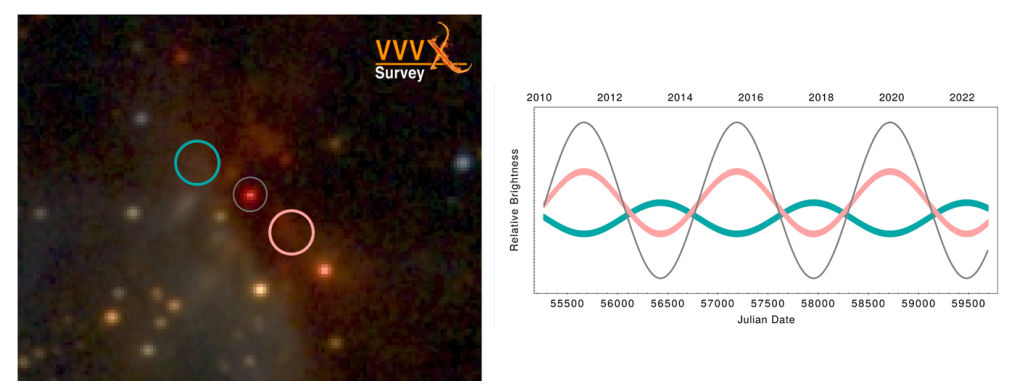An international team of astronomers lead by Prof. Roberto K. Saito of the Universidade Federal de Santa Catarina in Florianópolis, Brasil, reports the discovery of a unique object in our Galaxy. This object is located in the Scorpio constellation, close to the center of the Milky Way. It is observed as a peculiar combination of a variable star surrounded by a nebula that is also changing brightness. This discovery has been published on 2023 November 14 in The Astrophysical Journal Letters.
The discovery is made thanks to the VVV survey, that systematically mapped the Milky Way plane in the infrared with the VISTA telescope at ESO Paranal Observatory in Chile. The deep images accumulated along more than 12 years allow searching and monitor stars that change brightness with time. Tens of thousands of variable stars were discovered, that are classified according to their light curves. However, occasionally some object appears that cannot be easily explained because they do not belong to any of the known classes.
The VVV survey found a dozen such unidentified objects, that are called WIT, for “What Is This?”, and that represent very rare astrophysical phenomena. Such is the case of WIT-12, that was discovered in the infrared images using a simple technique that is generally applied to search for supernova light echoes. This technique consists of making color images using different observation epochs in the same filter. In this case the search was made using the images obtained in years 2010, 2011 and 2012 revealed a nebula that changes color, suggesting an interesting kind of variability. The follow-up study of the region revealed a red star located in the center of the nebula that changes brightness with a period of about 4 years. Follow-up spectroscopic observations made with the 4-m telescope SOAR at Cerro Pachón in Chile revealed that this central source is a very young stellar object that periodically illuminates the nebula. But the mystery does not end there, because the study that took so many years also revealed that the nebula changes brightness, and that one part varies in synch with the star, while the other part varies out of synch. That is, when the central star gets brighter, that part of the nebula fades.
This is an unknown phenomenon that perplexes the observers, motivating its classification as a WIT object, although the VVV team proposes a couple of explanations. This could be a central variable star that produces a light echo that reflects in the back part of the surrounding nebula. As the nebula is so extended, the light from the near side arrives directly to us, that region brightens when the star is brighter. On the other hand, the light that reflects on the more distant region of the nebula takes some time to travel, so it arrives later when the star is dimming. This phenomenon known as a light echo has been observed before in a few explosive events like novae and supernovae, but not in variable stars like WIT-12. Another possible explanation is the presence of a warped circumstellar disk that blocks light to different parts of the nebula as the warp moves around the star. This might be described as an "anti-light house", that illuminates all directions except one, in rotation. The final solution demands more observations and a new search for these kinds of objects, using telescopes like the future Vera C. Rubin Observatory.
The figure shows on the left the central star and two regions of the nebula encircled. Schematic light curves are displayed on the right, with colors corresponding to those on the left. While one region (red circle) is in phase with the stellar variability, the other one (cyan circle) is out of phase.
Contact: Dr. Bringfried Stecklum


